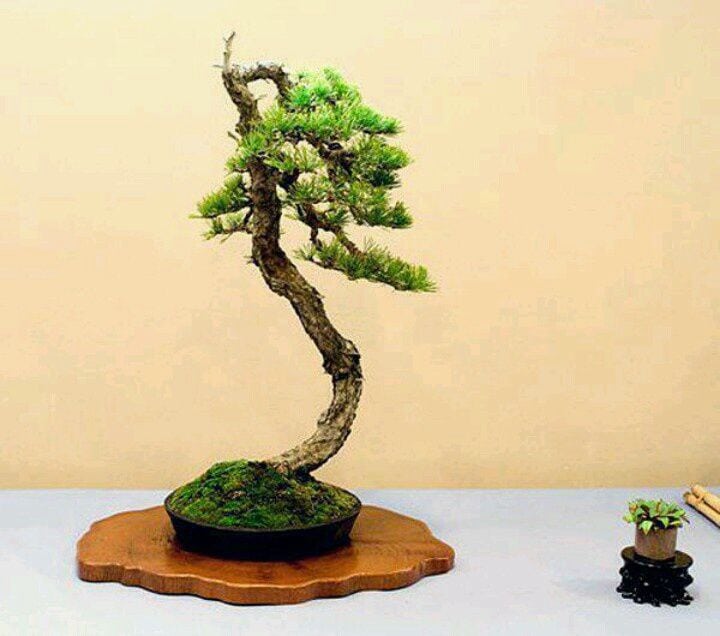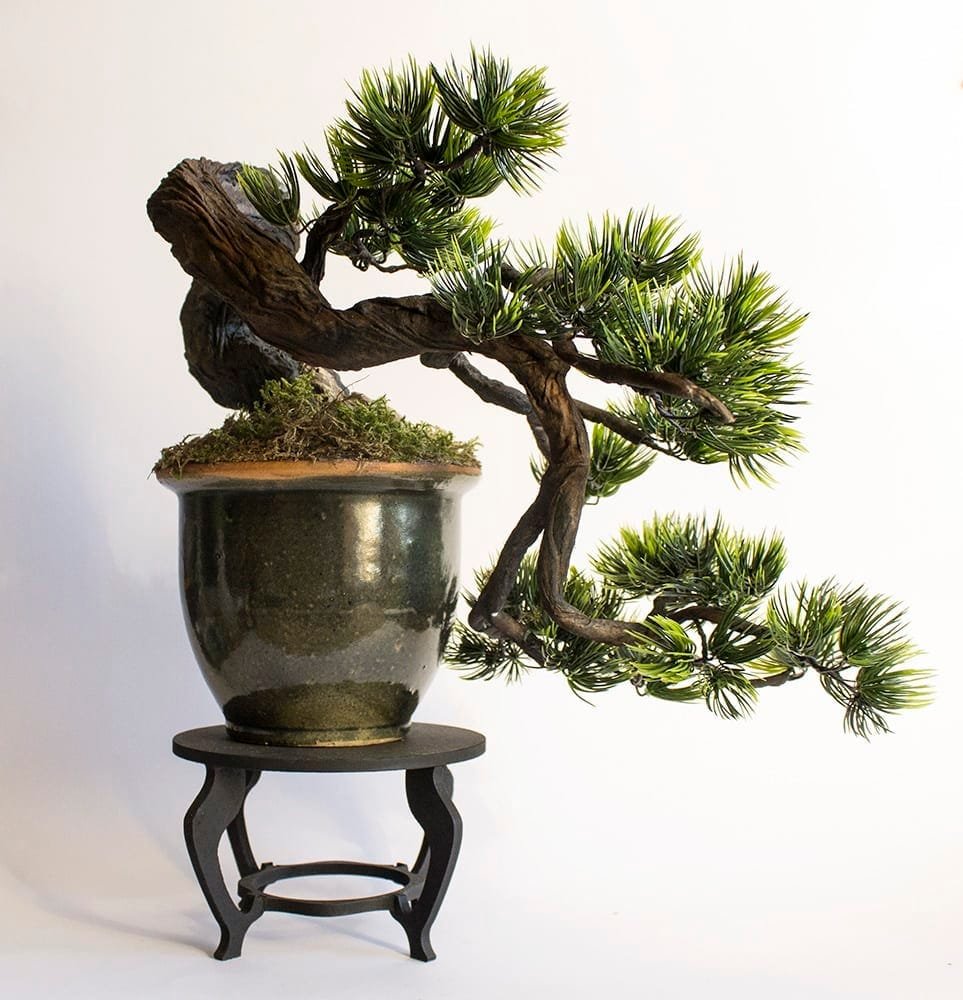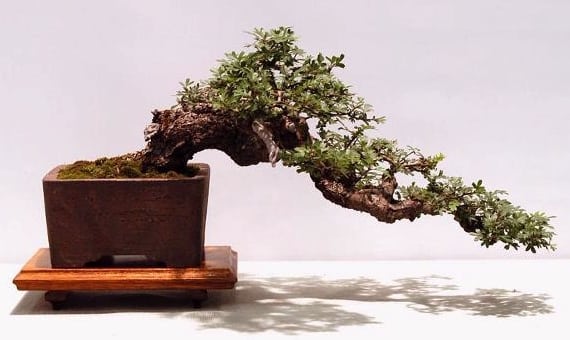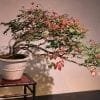I have always loved bonsai trees and found it challenging to do. I just love the way I can control trees and create balance in design. I must admit that my skills during the first few years of creating bonsai plants were crude but over time, I was able to gradually perfect it. And as I improved my craft, I found a few bonsai trees worthy of attention.
These cool bonsai trees have achieved balance and perfection. There is an overwhelming feeling of calmness as you look at these bonsai trees and this is why these are more preferred to grow more than other bonsai tree types. If you are looking for a challenging style or bonsai designs to inspire you then these cool bonsai trees are the best to try out.
1) The Shakan “Slanted Tree” Bonsai Style

The Shakan bonsai growing style is one of the classic bonsai tree designs. This style is very challenging and it could take many years to perfect. Consider this as your upgrade bonsai growing design as you perfect your style, talents, and skills in bonsai growing.
The Shakan is also called the slanted bonsai tree because it basically looks like a slanted tree. The trunk of the tree protrudes from the soil at a slanted position. This bonsai tree then straightens out to an outward position with the trunk in a 60-80 degree angle. Some branches may shoot downwards due to this complicated design but overall, it’s the imperfections that make the Shakan style perfect.
The Shakan style bonsai recreates the effect of a dominating blowing wind on trees. The dominant direction from where the tree bends or where a tree grows in the shadow makes the interesting Shakan style design. In making this design, the roots of the plant are well-developed on one side to keep the tree standing. But on the side where the tree is leaning, the roots are not very developed.
The first branch of a Shakan style bonsai grows opposite to where the tree leans. This is a very important technique to be able to create a sense of visual balance. The bonsai trunk could be slightly bent or straight but the leaves are thicker at the bottom compared to the leaves on the top.
To achieve a slanting and windswept style, you can utilize a variety of techniques. The most common technique used is strong wiring which helps control the growth of the main trunk to create the classic windswept look. Wiring may also help control the height of each branch but make sure to remove the wire from the branch before it digs into the bark of the trunk or branch.
Another way to create the slanting Shakan style is to apply strong sunlight from one direction only. It’s a fact that plants follow sunlight, therefore, a plant will grow towards the light and applying light in only one direction will help create a slanting bonsai style.
Another way to coax your bonsai plant to grow into a slanted position is by tilting the bonsai pot. Tilting the pot is an easy way to achieve a slanted effect to but make sure that water does not collect at one end of the pot because this can lead to root rot.
2) The Balanced Hokidachi Symmetry Bonsai Design

This is a symmetrical bonsai design similar to a broom. The bonsai has a straight trunk with a bell-shaped crown. The limbs and leaves are delicately positioned making this design simple yet graceful at the same time. A crest of leaves is found straight out over the trunk by about 1/3 of the tree’s height.
The Hokidachi style is suitable for deciduous trees that have extensive and fine branches. The ball-shaped crown makes for a wonderful décor during the winter season. To achieve this gracious design wiring is done to position the tree branches in a broom-style fashion. Continuous wiring will be able to create this kind of style and of course, pruning helps develop that dome-shaped appearance on the top.
3) The Dramatic Fukinagashi Fantasy Bonsai Tree Design

The Dramatic Fukinagashi is a surreal bonsai tree design which looks like a windswept head of hair in a storm. While this style may look unique and very impressive, it is more common than you may think. In the Fukinagashi style, the branches, as well as the trunk, grow to one side as if the wind has been blowing in one direction.
The most common techniques applied to create the Fukinagashi windswept bonsai style is wiring, using lighting and tilting the pot. The wire will control the growth of the trunk to one side while pruning the leaves and stems will create that strong windswept style. The leaves are thicker from the lowest part of the trunk and tend to become thinner at the top part of the plant.
4) The Natural Shari Bonsai Style

The Shari Bonsai Style is achieved by shaving the bark to keep new growth from appearing. Some Shari styles have a stair step effect with limbs randomly scattered along the trunk. Some branches may be long or short. Leaves may look like a platter of greenery at the top of the tree to give that aesthetic balance.
The Shari bonsai style is based on the natural development of some bonsai plants. Some trees may develop bald or barkless areas on their trunks due to harsh weather conditions. The bald area usually starts from the place where the roots emerge from the ground and become thinner as it moves up the trunk.
You will need a sharp knife to remove the thick bark to create a barkless area on the trunk. A chemical called calcium sulfate is used to bleak the barkless area.
5) The Seki-joju or Rocky Terrain Bonsai Tree Design

The Seki-joju or Rocky Terrain style is basically growing bonsai around an obstacle like a jagged or smooth rock. This happens in regular trees as the roots of trees grow underneath nearby rocks. The roots stretch and grow along all sides of the rock in search of daylight. Roots will crawl around the rock surface and as the trunk of the bonsai has formed, the tree will continue to grow in a straightforward manner.
The Rocky Terrain is a sight to behold because of the control of a miniature tree over a piece of rock. Root pruning is done to help roots move around a piece of rock. Not all trees may be used to grow a Rocky Terrain style. Usually Juniper Bonsai and tropical like Ficus Bonsai are the best candidates.
The roots of trees in design are not just pruned but are also moved inch by inch to conform to the design you want to achieve. You might place a piece of pottery, a rock or a tile to create different root designs. Roots are moving, breathing tree parts and it will naturally do what it does best for the tree. It will naturally move and grow someplace else just to move through an obstruction.
The end result of training tree roots to create a rocky terrain design is amazing. Not only will you be able to promote your ability to prune and wire your tree but also to tame and design its roots as well.
6) The Classic Literati Bonsai Tree Design

The Literati style is characterized by a skinny trunk and a number of curves with very few leaves. Growers and enthusiasts agree that this style depicts the struggle in nature to preserve even the tiniest form of life. A few bald spots exist to recreate the presence of dead branches.
The Literati bonsai style is present in nature especially in areas that are densely populated by other trees.
The trunk in this style is bent and grows crookedly upwards. This is achieved by allowing the sun or artificial light to hit only the top part of the tree. The bark of the bonsai may also be removed to make the miniature tree look tougher. The general idea of a Literati style is that the tree has underwent struggle to survive. This style will look perfect in small round pots.
7) The Cascading Kengai Bonsai Tree Design

This is a downward flowing slope growth and is created by growing the bonsai in a tall, cylinder pot. As the trunk creates roots in the soil, it only rows a short way before it moves along the side of the container. There is a noticeable S-shaped pattern in the natural setting. The cascading style may be observed in nature as well. Some plants that grow in steep cliffs can bend downward
Usually cascade bonsai are planted in tall pots. The young tree should grow upright for a small stretch but because of natural factors this bend forward. The crown of Bonsai tree should grow about the rim of the pot. Branches grow alternatively and should grow horizontally to maintain the balance of this tree
Wiring will help promote the cascading effect that this style is known for. Pruning the leaves and stems will help maintain the relaxing cascading effect and of course the tree.
8) The Cascading Han-kengai Bonsai Tree Design

This style is quite similar to the cascading style but is not as dramatic. A section of the trunk may be grown straight while a branch may be allowed to grow outward and slightly downward. There is only a small area of the trunk before the thick branches which grow in different directions. The leaves are low-lying and because of this style, a deeper pot is ideally used to control and preserve this formation.
Also known as the semi-cascade, this style is mostly seen in nature in trees on cliffs and along the river banks and edges of lakes. The cascading growth will not grow below the bottom of the pot and the crown is found above the rim of the pot while subsequent branching is found at below the rim of the pot. Generous use of wires and guy wires is needed to control the growth of this semi-cascading style.
9) The Netsuranari in Horizontal Display Bonsai Tree Design

This is a horizontal display that depicts a fallen tree in the forest. The tree trunk is where all sorts of plant life form and this are possible because of a small patch of sunlight peeking through a small crack in the tree. It is one of the most complicated styles because it looks like several trees have been planted in succession but it is actually due to a strong root system. The netsuranari horizontal display needs a low planter to present the trunks and limbs in a straight, curved or slanted position. Wiring and pruning are also needed to consider a resilient type of tree to use for this display.
10) The Yose-ue/Forest of Bonsai Trees Design

This style is a collection of bonsais planted in a round, flat container. This is a display that requires good bonsai growing skills as well as patience and dedication. One tree is plated in the middle of the container and the roots of this plant will spread horizontally and begin to grow. As the separation of the trunks takes place, there will be multiple trunks that protrude from the soil. Smaller trees on either side will create a staggered look that resembles a forest.
The forest appearance is achieved by using a variety of wiring techniques as well as pruning strategies. Be patient and don’t rush this style. You will soon achieve this forest style in no time.
Conclusion
These ten cool bonsai designs are just some of the many bonsai displays you can learn and apply. It is always a challenge to learn to create classic bonsai styles but it is also rewarding to create your own designs. The key is to handle your bonsai tree with utmost care and to follow wiring techniques well. Give your plants ample nutrients and water every day and soon you will be rewarded with a lovely bonsai with beautiful, balanced characteristics.


